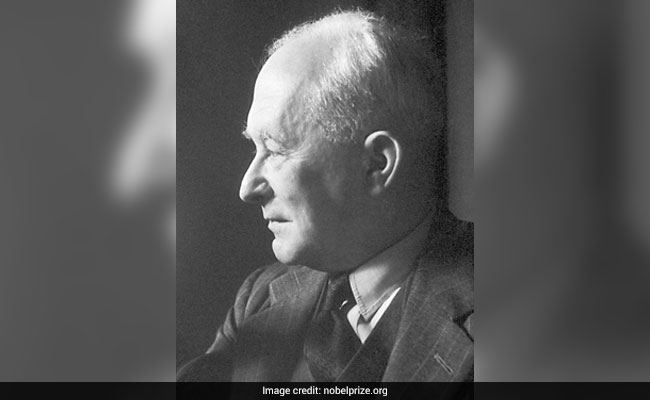
Max Born: Google Doodle Honours German Physicist, Mathematician
New Delhi:
German Physicist and Mathematician, Max Born, is much popular and revered when it comes to Quantum Mechanics. Born on this day (11 December) in the year 1882, Max Born has made immense contribution in the field of physics and mathematics. He won the prestigious Nobel Prize in 1954 for his fundamental research in Quantum Mechanics, especially in the statistical interpretation of the wave function. Google honours the pioneer today with a Doodle portraying Max Born holding 'psi' the symbol for wave function, created by guest artist Kati Szilagyi, to commemorate his 135th birthday.
Also Read: Max Born's 135th Birth Anniversary: Google Celebrates Nobel Prize Winner's Birthday With A Doodle

Born Rule
Otherwise called as Born's Law, was formulated by Max Born states that the probability density of finding the particle at a given point is proportional to the square of the magnitude of the particle's wavefunction at that point. One of the important principles of Quantum Mechanics, Born's law was one of his other works that gave him the Nobel Prize in 1954 along with Walther Bothe.
PhD from University of Gottingen, Research on Special Relativity
Born in Poland (known as Wroclaw, then), Max Born joined the University of Gottingen in 1904. His PhD thesis entitled 'Stability of Elastica in a plane and space' won him the University's Philosophy Faculty Prize. A year later after joining the University, he began his research on special relativity being inspired by Albert Einstein's research paper 'On the Electrodynamics of Moving Bodies'. He along with Professor Hermann Minkowski began his research on four dimensional space-time.
Born-Haber Cycle
Max Born along with Fritz Haber (German Chemist who won the Nobel Prize in 1918 for the Haber-Bosch Process; a process to synthesize ammonia from nitrogen and hydrogen gas) found the Born-Haber Cycle. This is used to calculate the lattice energy; in an exothermic process where an ionic compound is formed from gaseous ions or in an endothermic process where an ionic compound breaks down to gaseous ions; only in case of fully ionic solids.
Born Rigidity
This concept of special relativity was formulated by Max Born in 1909 in his article 'The Theory of Rigid Bodies in the Kinematics of the Relativity Principle'. Based on his research on special relativity which he had begun with Professor Minkowski, Born introduced this concept after the death of the Professor at a meeting of Gottingen Mathematics Society.
Other Contributions
His other contributions in this field are Born Coordinates, Born approximation, Born probability, Born-Infeld theory, Born-Oppenheimer approximation, Born-Land6 equation, Born-Huang approximation, Born-von Karman boundary condition, Born equation.
Much before the Nobel Prize, Max Born had won a number of accolades in the field of Physics and Mathematics. He became a Fellow of the Royal Society of Edinburgh and Royal Society of London in 1937 and 1939, respectively. In 1972, the German Physical Society and the British Institute of Physics started the Max Born Prize, which is awarded annually. In 1982, University of Gottingen observed the 100th birth year of Max Born and James Franck.
He breathed his last on 5 January 1970 at Gottingen, Germany.
Click here for more Education News
Also Read: Max Born's 135th Birth Anniversary: Google Celebrates Nobel Prize Winner's Birthday With A Doodle

Born Rule
Otherwise called as Born's Law, was formulated by Max Born states that the probability density of finding the particle at a given point is proportional to the square of the magnitude of the particle's wavefunction at that point. One of the important principles of Quantum Mechanics, Born's law was one of his other works that gave him the Nobel Prize in 1954 along with Walther Bothe.
PhD from University of Gottingen, Research on Special Relativity
Born in Poland (known as Wroclaw, then), Max Born joined the University of Gottingen in 1904. His PhD thesis entitled 'Stability of Elastica in a plane and space' won him the University's Philosophy Faculty Prize. A year later after joining the University, he began his research on special relativity being inspired by Albert Einstein's research paper 'On the Electrodynamics of Moving Bodies'. He along with Professor Hermann Minkowski began his research on four dimensional space-time.
Born-Haber Cycle
Max Born along with Fritz Haber (German Chemist who won the Nobel Prize in 1918 for the Haber-Bosch Process; a process to synthesize ammonia from nitrogen and hydrogen gas) found the Born-Haber Cycle. This is used to calculate the lattice energy; in an exothermic process where an ionic compound is formed from gaseous ions or in an endothermic process where an ionic compound breaks down to gaseous ions; only in case of fully ionic solids.
Born Rigidity
This concept of special relativity was formulated by Max Born in 1909 in his article 'The Theory of Rigid Bodies in the Kinematics of the Relativity Principle'. Based on his research on special relativity which he had begun with Professor Minkowski, Born introduced this concept after the death of the Professor at a meeting of Gottingen Mathematics Society.
Other Contributions
His other contributions in this field are Born Coordinates, Born approximation, Born probability, Born-Infeld theory, Born-Oppenheimer approximation, Born-Land6 equation, Born-Huang approximation, Born-von Karman boundary condition, Born equation.
Much before the Nobel Prize, Max Born had won a number of accolades in the field of Physics and Mathematics. He became a Fellow of the Royal Society of Edinburgh and Royal Society of London in 1937 and 1939, respectively. In 1972, the German Physical Society and the British Institute of Physics started the Max Born Prize, which is awarded annually. In 1982, University of Gottingen observed the 100th birth year of Max Born and James Franck.
He breathed his last on 5 January 1970 at Gottingen, Germany.
Click here for more Education News
